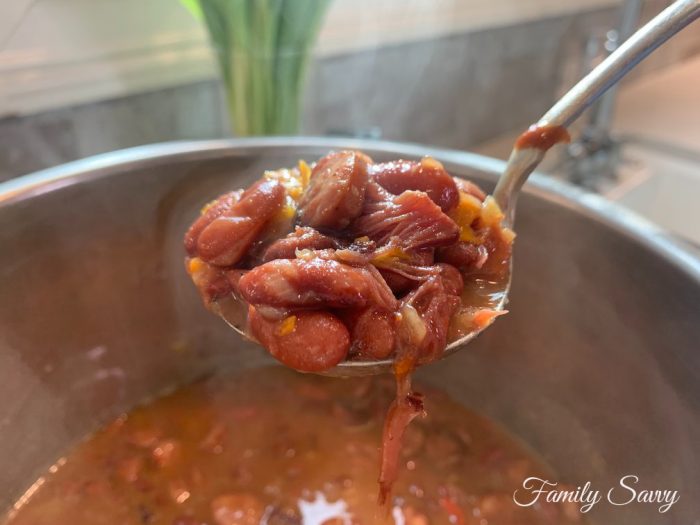10 Tips To Prevent Food Poisoning
Here are 10 tips to prevent food poisoning~a dreadful but usually preventable result of improper food handling, prep, and storage.
If you’ve never had food poisoning, be thankful. If you have, you know how utterly AWFUL it is. The bad news is that some incidents of food-borne illness are unavoidable; the good news is that many incidents CAN be prevented by following simple rules in your kitchen.
Below are 10 of the most helpful tips for keeping food safe and bacteria free in your own kitchen. These tips are good to pass along to family, friends, and others with whom you enjoy meals regularly.
- Wash hands. This is the simplest resolution but one of the most important. The recipe for effective hand washing is simple. Soap + warm water + 20 seconds = germ free hands. Washing is important before cooking and after handling any raw meat, eggs, produce, or garbage. (Try making this homemade moisturizing hand scrub to keep near your kitchen sink).
- Use a fridge thermometer. A fridge should stay below 40 degrees Fahrenheit in order to keep food from developing bacteria. A good thermometer helps keep tabs on the temp so that you can adjust as needed. I have a Taylor Digital Refrigerator Thermometer in both of my fridges. Whenever the temp rises to 40 degrees, I either clean out some of the excess food or adjust the temp (and try to keep the fridge door shut

I am no cook, but I can follow directions. Which said to let the turkey chill in the sink for a few hours… until the temp lowers to safe levels).
- Never thaw frozen food on the counter. The best way to safely thaw frozen food is in the fridge. For large roasts, birds, or casseroles, placing in the fridge 2-3 days ahead is best. The photo at right (texted to me by a hilarious friend of mine right before Thanksgiving) is a humorous way to show how NOT to thaw a turkey!:-)
- Use a food thermometer. One of the most important tools in any kitchen, a food thermometer tells the internal temperature of food at the thickest part. Eyeballing food or even cutting into it isn’t an accurate way to gauge temp. The CDN Digital Thermometer is my favorite, and I keep two on hand any time I am cooking meat.
- Ditch the sponge; use washcloths instead. A sponge is one of the dirtiest items in most kitchens unless it is routinely being soaked in bleach or zapped in the microwave. Kitchen washcloths can be used and tossed into the washer. Clean washcloths are the easiest, safest, and savviest way to keep a clean kitchen!
- Check expiration dates. A quick expiration date check for fridge, freezer, and pantry items will almost always turn up foods that need to be tossed.
- Don’t cook for others when you are sick. Even good hand washing won’t protect friends and family from certain bacteria that can be passed along when you are ill~especially with gastrointestinal issues (vomiting & diarrhea). Even the common cold can spread germs with coughing and sneezing. When sick, taking a break from the kitchen is a good idea (and a great excuse for take out:-).
- Wash produce before eating or prepping. All produce should be rinsed/washed well. I keep a spray bottle of half hydrogen peroxide and half water to spray on produce before rinsing. Rinsing with this or water is likely to remove most germs. Even rinds that will be discarded (melons, pineapple, etc…) should be washed before cutting so that a knife won’t slice into (and spread) any exterior germs.
- Cool cooked food safely. Cooked foods should be refrigerated in shallow containers (less than 4″ deep) soon after eating or preparing. Never put food in deep containers (slow cooker or Dutch oven) into the fridge. Food should be in a shallow layer so that it will all cool evenly and quickly. For safe storage of large batch items (chili, soup, and stew), I use this Rubbermaid 24-Cup storage container that is large and shallow.
- Toss leftovers after 3 days. Some literature will suggest 4 days, but I err on the side of caution.
Below are a few photos of my favorite tools for food safety, followed by a savvy piece of advice for food safety when eating out.
I hope 2015 is your best year yet! Thanks so much for being a reader. As always, be blessed, and stay savvy!!!
A note on eating out: No matter how safe you are in your own kitchen, you are always vulnerable  when eating out. One way to determine how well a restaurant follows food safety it to take note of safety inspection scores that are (or should be) posted in all restaurants where states require it.
when eating out. One way to determine how well a restaurant follows food safety it to take note of safety inspection scores that are (or should be) posted in all restaurants where states require it.
My personal rule of thumb is that I avoid eating in any restaurant with a score less than 90. Any score below 90 is likely to have one or more 5-point infractions~critical items related to food temperature, safe storage, and food handling.
Before I eat out, I often check this link to Jefferson County restaurant inspection scores (restaurants in my area). On more than one occasion, we have cancelled plans to eat at a particular place based on a poor health score.
This link is for restaurant scores in all Alabama counties. For those of you who live in other states that require health scores, you can likely find a link by visiting your state government’s website.









